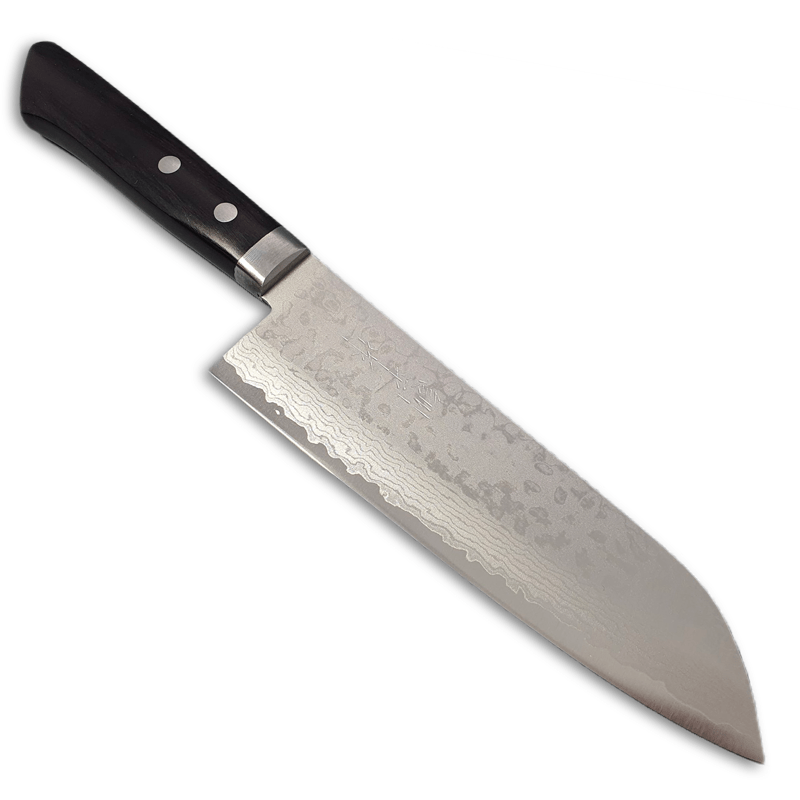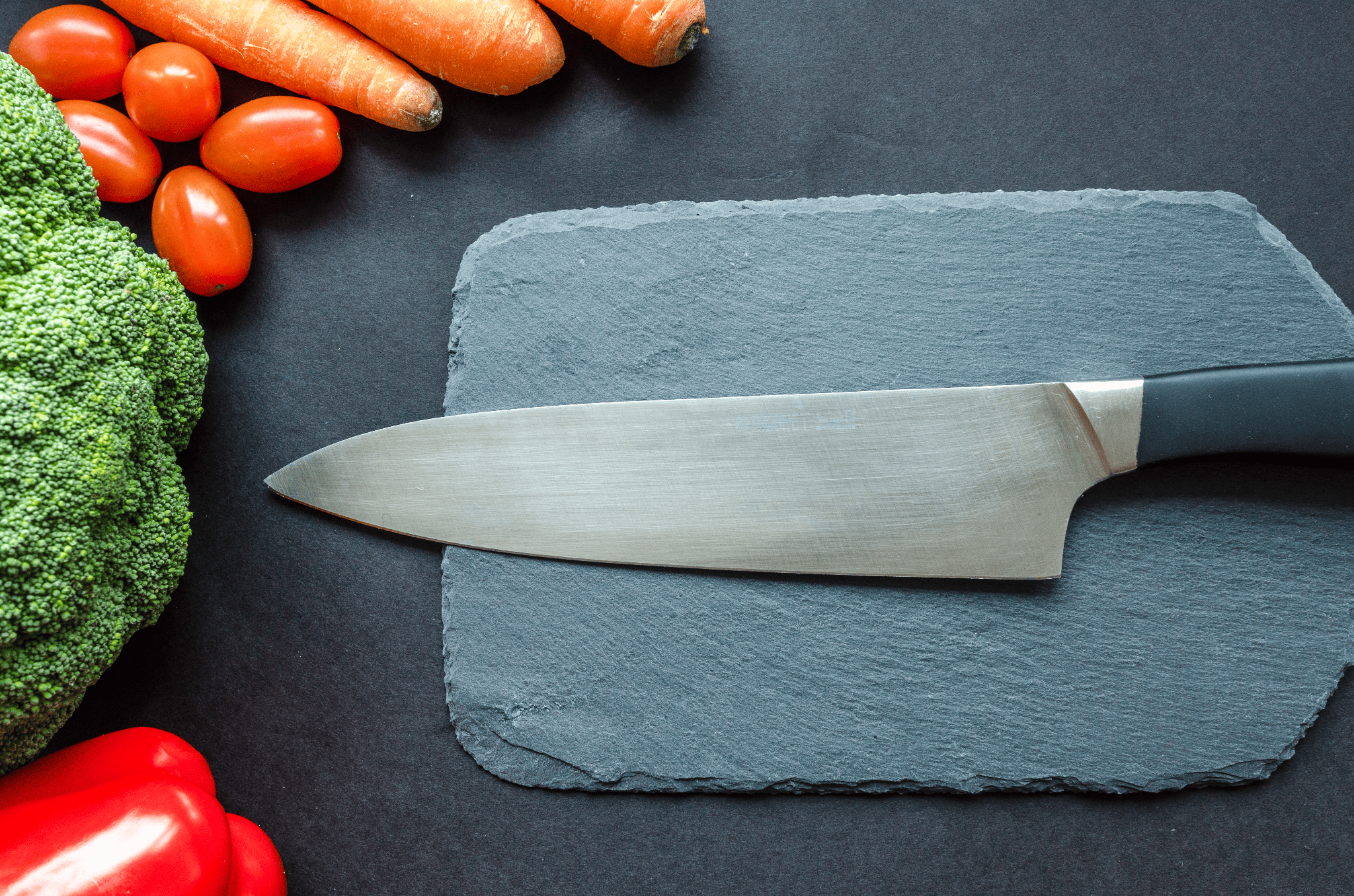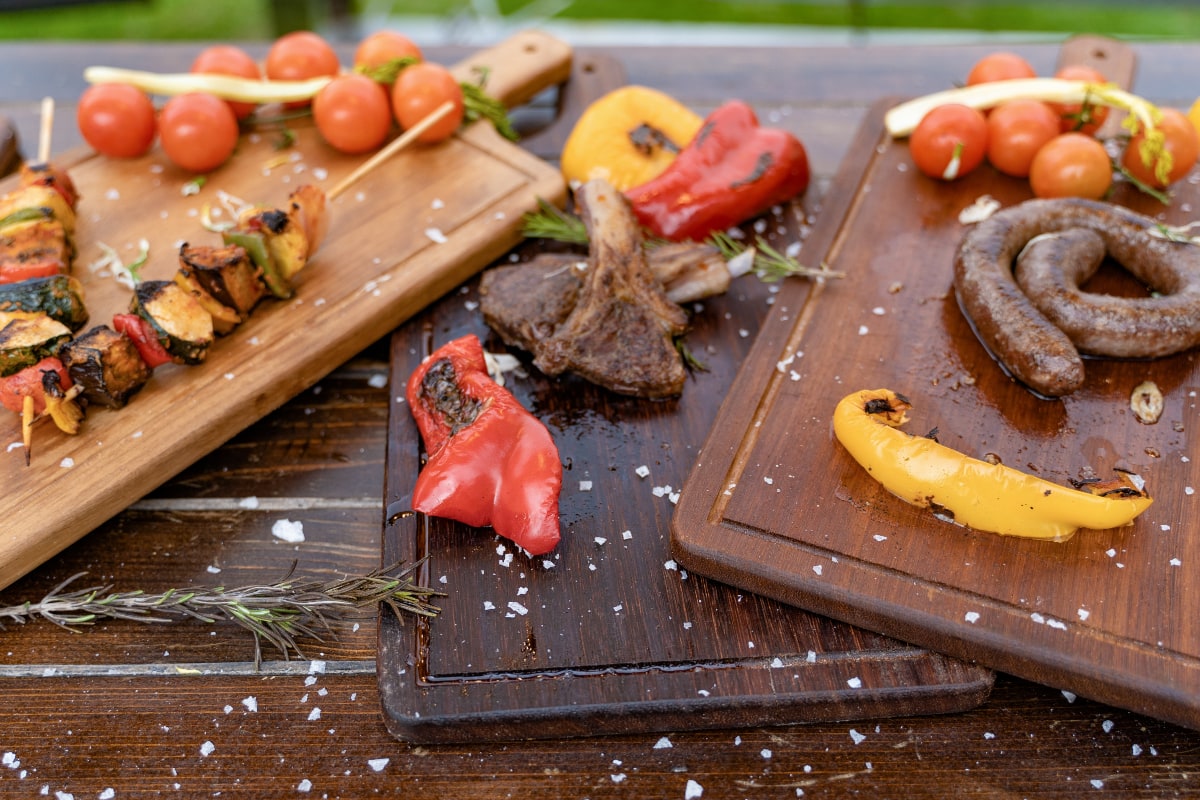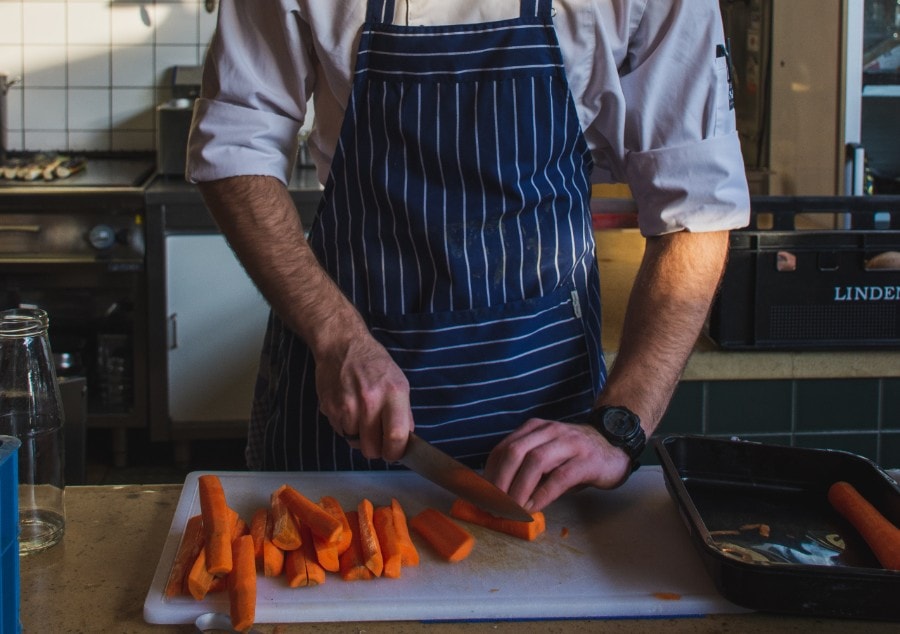Different knives are better for various tasks, and it all depends on what you’re looking for in a vegetable knife. This article will discuss the seven best knives for cutting vegetables and how to use them. We’ll also look at their popularity, pros, and cons.
So, read on whether you’re looking for the best all-around vegetable knife or the best knife for a specific task. We’ll help you find the right vegetable knife for your needs.
7 Best Knives for Cutting Vegetables
Chef’s Knife
A chef’s knife is a versatile tool that can be used for various tasks in the kitchen, from chopping vegetables to slicing meat. While there are many different types of chef’s knives available on the market, the best vegetable knife is typically a serrated knife.
A chef’s knife is designed specifically for cutting through tough, thick-skinned vegetables like squash and pumpkins. The serrated blade of a chef’s knife will allow it to glide through the vegetable with ease, resulting in perfectly chopped pieces.
Additionally, the tips of the blades are often curved, which makes it easy to create thin, flawless slices. When using a chef’s knife, it is essential to use a sawing motion rather than a chopping motion. This prevents the vegetables from being bruised or damaged.
Furthermore, it is essential to avoid using too much pressure when cutting, as this can cause the blades to be dull quickly. While a chef’s knife is considered one of the best vegetable knives, they do have some drawbacks. For instance, it is difficult to sharpen a chef’s knife without the proper tools and experience.
Paring Knife
A paring knife is a small, sharp blade that is typically used for peeling and slicing fruits and vegetables. While it can be used for other tasks in the kitchen, such as mincing garlic or slicing cheese, a paring knife is best suited for delicate cutting tasks.
The size of a paring knife is one of its most appealing features. Because it is smaller than other knives, it is less difficult to handle and this makes it a good choice for jobs that require precision, such as removing the seeds from jalapeno pepper.
In addition, a paring knife is less likely to cause injury than a larger blade because it requires less force to use. However, one downside of a paring knife is that it can be difficult to slice through tough vegetables, such as carrots or potatoes.
As a result, many cooks choose to use a larger blade or Santoku knife for these tasks.
Santoku Knife
A Santoku knife is a Japanese-style all-purpose kitchen knife that is great for cutting vegetables. It has a sharp, thin blade that is perfect for slicing and dicing vegetables.
These knives are quite a good choice for home cooks who want a versatile vegetable knife that can handle many different tasks. While these knives are an excellent choice for slicing vegetables, it does have some drawbacks.
- First, these kitchen knives are not as well suited for chopping through more challenging foods, such as squash or pumpkins. Second, Santoku knives can be pretty expensive, so they may not be the best choice for budget-minded
- Second, the Santoku knife can be more challenging to control than a chef’s knife because of its thinner blade.
Nevertheless, the Santoku knife is still an excellent option for home cooks who want a versatile and sharp knife for their kitchen.
You can learn more about the Santoku knife in our comprehensive guide here.
Fillet Knife
A fillet knife is a kitchen tool that is designed explicitly for cutting-up vegetables. It features a narrow long blade that is ideal for slicing and chopping a wide variety of vegetables into tiny thin strips or small pieces.
Fillet knives are also very lightweight and maneuverable, making them easy to control when cutting delicate or fragile vegetables. While a fillet knife may not be the best choice for every kitchen task, it is an essential tool for any cook who frequently prepares meals with fresh vegetables.
Nakiri Knife
The Nakiri vegetable knife is a Japanese-style knife that is best known for its ability to easily and evenly slice vegetables. Because of its sharpness and thin blade, it is also a popular choice among chefs and home cooks for other tasks such as mincing and julienning.
However, the Nakiri vegetable knife does have some drawbacks. For example, its relatively short length can make it difficult to cut through large vegetables or thick cuts of meat. In addition, the Nakiri knife is not suitable for chopping because the blade is too thin and fragile.
Despite these drawbacks, the Nakiri knife remains one of the best choices for cutting vegetables, thanks to its sharpness and versatility.
Utility Knife
It is widely believed that the best knife for cutting vegetables is a utility knife. Utility knives are designed for a variety of tasks, including slicing and chopping.
They typically have a serrated blade, which helps to grip the food and prevent slipping. Additionally, utility knives often have a blunt tip, which is ideal for safely cutting vegetables. The best utility knives are made from high-quality materials, such as stainless steel or high carbon steel.
They should also be well-balanced and comfortable to hold. While utility knives are an excellent choice for cutting vegetables, they do have some drawbacks. For example, A utility knife can be difficult to sharpen and may require frequent replacement.
Additionally, they are not as well-suited for precision work as other types of knives. Nevertheless, utility knives remain one of the best options for safely and effectively cutting vegetables.
Chinese Cleaver
The Chinese cleaver is a versatile kitchen knife that can be used for a variety of tasks, from chopping vegetables to slicing meat. While it may look like a large butcher knife, the Chinese cleaver is actually much lighter and easier to handle.
The blade is also thinner than a butcher knife, making it ideal for the precision slicing of a wide variety of vegetables. When used correctly, the Chinese cleaver can make quick work of even the toughest vegetables. Here are some tips for using this versatile kitchen tool:
- To chop vegetables, place the cleaver on the cutting board with the blade facing up. Place your hand on top of the blade and use a rocking motion to chop the vegetable into pieces.
- To mince garlic or ginger, first, peel off the skin. Then place the garlic or ginger on the cutting board and hold it steady with your fingers. Use a back-and-forth motion to mince it into small pieces.
There are some things to keep in mind when using a Chinese cleaver: because the blade is so thin, it can be easily damaged. Be sure to use a cutting board that is soft enough to protect the blade.
While the Chinese cleaver is an excellent choice for slicing and chopping vegetables, it does have some drawbacks. For example, it is not as well-suited for precision work as other types of knives.
Additionally, the thin blade can be easily damaged if not used properly. Nevertheless, the Chinese cleaver remains a popular choice among home cooks and chefs, thanks to its versatility.
Factors to consider when buying a new knife
There are a few factors to consider when buying a new vegetable knife.
Type of steel
Stainless steel is the most common option and is known for its durability and corrosion resistance. However, high carbon steel is sharper and holds its edge longer. Damascus steel is even stronger and more durable, but it can be more challenging to sharpen.
The Tang
A full tang runs the full length of the knife, making it more balanced and less likely to break.
Consider the handle
Ergonomic handles are more comfortable to hold and provide a better grip, making them ideal for extended use.
With these factors in mind, you’ll be sure to find the perfect vegetable knife for your kitchen.
Tips on cutting or slicing vegetables
When it comes to cutting or slicing vegetables, there are a few things to keep in mind.
- First, make sure you have a sharp knife. A dull knife is more likely to slip and could result in an injury.
- Second, cut vegetables into uniform pieces so they will cook evenly.
- And finally, take your time and be careful. Vegetables can be hard to cut, so it’s essential to go slowly and be precise.
With these tips in mind, you should be able to cut or slice any vegetable with ease.
So, Which one is the best?
The best knife for slicing vegetables is the one that best suits your needs. If you frequently prepare meals with fresh vegetables, then a Nakiri knife or fillet knife would be a good choice.
However, if you are looking for a versatile and durable knife, then a utility knife or chef’s knife would be a better option. Ultimately, the best knife is the one that you are most comfortable using.
With a bit of practice, any of these vegetable knives can be used to safely and effectively cut vegetables.
Where to find these knives?
If you are looking for a great quality knife for cutting or slicing vegetables, Damas-Knives is the perfect place to shop. We carry a wide variety of knives, including fillet knives, Nakiri knives, and utility knives.
Our knives are made from high-quality materials and are designed for precision and durability. In addition, our blades are well-balanced and comfortable to hold. So, whether you are a home cook or a professional chef, Damas-Knives has the perfect blade for you.
Do you have a favorite type of knife? Let us know in the comments below!
Happy cooking! :)”



